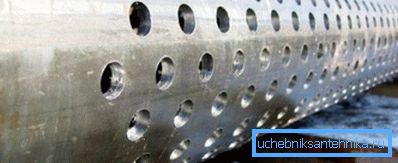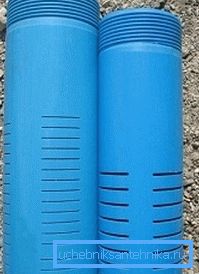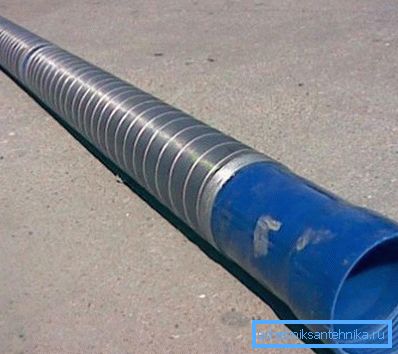How to make a filter for the well do it yourself
If you are going to provide a country house with autonomous water supply using a well, then it should be borne in mind that the quality of the water and the durability of the system is largely responsible for the filter, which is immersed in the aquifer. Therefore, its quality should be given special attention, and best of all, to make a filter for the well with your own hands. Next we look at how to do it correctly.
The well filter is the lowest element of the casing, which is also called the working area. Its main task is to prevent the ingress of large particles of soil into the structure and provide clean water with free access to the column. In addition, it additionally protects the walls from shedding and collapse of the trunk.

Most commonly used downhole filters of two types:
- Perforated;
- Slotted.
Next, we consider the features and stages of their manufacture.

Perforated Hole Filters
The most common system of water purification from a well is perforated. It is a conventional perforated pipe covered with a mesh, so making a filter for a well with your own hands is not difficult. In addition, this device has excellent performance properties.
Therefore, if you are going to make a filter on the well with your own hands, then you can stop at this design. The main advantage of this system is low cost. This design can be used in different rocks, most often it is used in artesian wells that have an unstable aquifer and a small pressure.
The design consists of several parts:
- The filter itself;
- Over the filter;
- A sump in which large particles of soil accumulate (located at the very bottom of the barrel).
Now let's take a closer look at the process of making the structure.

Necessary tools and materials
For the manufacture of the device will need:
- Steel pipe of the required diameter. You can also use a plastic pipe, but you need to pay attention so that it is made of a material that can be used for food purposes.
- Also need a drill of the required diameter. The size of the holes is selected in accordance with the grain size distribution of the soil.
- Electric drill.
- Grid for the filter.

Tip! You can choose the size of the mesh holes by sifting sand from the aquifer. Use should be the grid that misses about 50 percent of the sand.
Manufacturing
Instructions for the manufacture of the device is as follows:
- The length of the sump is measured first.
- Then the pipe is laid on a flat horizontal surface, after which a marking is applied to it. It should be borne in mind that the perforated area, according to technology, should be about 25 percent of the total length.
- The next step is to make the holes. At least one meter should be removed from the edge. The interval between the holes should be 1-2 cm. It is advisable to drill them at an angle of 30-60 degrees from the bottom up.
- After completion of work, it is necessary to clean all sharp edges and carefully tap the product so that no metal chips remain in it.
- It is desirable to close the lower part of the pipe with a wooden stopper.
- To protect the holes from clogging, the pipe is wrapped in a mesh for the well filter.

Slot filters
Filters of the slit type are usually used in rocks that are prone to collapse. Their design is preferable in that it has a greater capacity. There are no “deaf” zones on the surface of such a product, and the slot area is much larger than the opening area.
The main disadvantage of the design is lower flexural strength, given this point in the manufacture, it is necessary to provide stiffness belts, i.e. areas without perforation.
Necessary tools and materials
To manufacture the device you will need a pipe, the same as in the first case, as well as:
- Cutting torch;
- Wire diameter of 3 mm;
- Grid.
Manufacturing
Such filters for wells with their own hands are made according to the same principle as perforated ones. Cuts can be made in a staggered or belt order. The width of the slots is determined depending on the composition of the rock.
As in the first case, a metal grid should be used over the pipe. As practice shows, the best option is brass mesh galunnogo weaving.
Before you put a grid on the pipe, it is necessary to spiral-wrap stainless steel wire on it in increments of about 20 mm. After every half meter, along the length of the pipe, the wire must be soldered to ensure maximum rigidity of the structure.

Such a homemade filter for the well is durable and excellent throughput. At the same time, the cost of its manufacture will be significantly lower than the price of the finished product.
Tip! The mesh can be soldered to the wire, which will allow you to get a solid construction.
Gravel filtration building
This filtration system is the easiest to manufacture and at the same time also copes well with the task. It is possible to build such a structure in small and clayish structures.
Work is performed in the following order:
- The hole for the well is drilled with a slightly larger diameter than necessary.
- Gravel is carefully selected and calibrated - fractions should be approximately the same size. In this case, the average particle size of the rock should be less than fractions of 5-10 times.
- Then the well is filled with gravel from the mouth. The thickness of the dusting should be about 50 mm.
Conclusion
When constructing a well filter, it is more expedient to perform the filter yourself. It does not take much time and effort. The only thing to keep in mind is that this work is very responsible, and it must be carried out strictly in accordance with the above technology.
Additional information on this topic can be obtained from the video in this article.